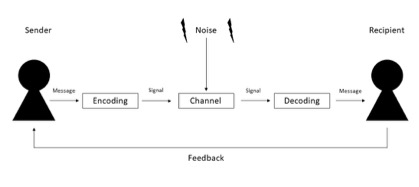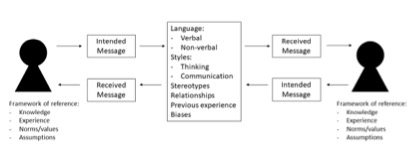Communication Failures: Moving away from the Traditional Model

Have you been in a situation where you sent a very friendly email where the receiver seemed to have read something completely different and perceived it as a criticism? Or when you thought you were being polite and professional during an interview and still failed to secure the project? This post aims to give you a brief idea of what you could have missed.
When it comes to communication, it is most often the case that we think about the traditional model from Shannon & Weaver (1949) where the focus was on the linear approach of one individual transmitting a coded message over a specific channel and another individual, who in turn decoded the message and provided feedback (see fig. 1).

According to this approach, problems in communication arise in the following cases:
- Sender fails when encoding the soon to be sent message: This can happen when language skills are not good enough, when information is left out or when for example there are typos or wrong expressions in written form.
- Noises in the channel: This can happen for example when pieces of the message get lost due to environmental noise, problems in the internet connection or errors in for example email reception.
- Receiver fails to decode the message: An example is when the individuals involved don’t share the same language or skill level, when the subject is unknown to one of them or not enough information is shared.
However, communication between individuals can be ineffective and fail even if there was no noise in the channel and the code is shared between two individuals with the same language and skill level. So, what is missing in this approach?
Research in cross cultural communication has shed light on this topic and has brought other aspects of communication to our attention that were not considered in the linear model in 1949. The research has led to a revised model that focuses on how complex the sender and receiver codes are and how cultural aspects and mindsets influence and determine what we share and understand.
Problems that the research identified:
- What if there are regional or national differences in the words we use even if the language is the same (e.g. American vs British English)?
- What if, what we perceive as “enough information” is perceived differently by the receiver? What if sharing too many details ends up in our message being confusing more than clarifying? What if we share too few details and the details are perceived as not “proficient enough”?
- How about profession specific words? Can we be sure the message will be understood if we use too many profession specific words? But how do we sound professional if we don’t?
- What role do non-verbal elements of communication play? How do face gestures and intonation influence what is being understood?
- How do I behave in face-to-face communications? How much should I speak? If I disagree, should I say so? Should I ask questions when they come to mind? Should I save them to the end? Or send them in an email? Should I not ask them at all?
These identified problems make each communicative interaction much more complex than a simple transmission of ideas and a feedback confirmation that the message was “received correctly”. This also implies that we need to shift our attention away from channel quality and towards acknowledging the mindset of both the sender and the receiver. The cross cultural communication model by Browaeys and Price (2011) captures this complexity, incorporating further dimensions and differentiating the intended message from the received message (see fig. 2).

In summary, as individuals become more diverse and exposed to different mindsets (which can vary from profession, age, nationality, etc.), communication also becomes more complex. In order to achieve effective communication your approach needs to adjust accordingly.
Learn more in the upcoming Webinar
The Webinar, Up Skilling with Tamara: Communication Failures, will outline a roadmap that will help you navigate complex cross-cultural communication situations. The interactive session will allow you to collaboratively work through difficult scenarios you have experienced. You will walk away from the session holding the tips and strategies you require to engage in effective communication.
You can sign up to the webinar here.
References:
Browaeys & Price ( 2011) Understanding Cross-Cultural Management, United Kingdom, Pearson.
Geiger, I. (2015). Strategies of Business Relationship Management. En M. Kleinaltenkamp, W. Plinke, & I. Geiger, Business Relationship Management and Marketing (págs. 153-192) Berlin Heidelberg, Springer-Verlag.
SHANNON, C. E. & WEAVER, W. (1949) The mathematical theory of communication, Urbana, University of Illinois Press.
Oct 2019 - 3 min read

Prof. Tamara Pawluk
Tamara is a professor in Intercultural Business Management and is finishing her PhD Thesis on Diversity Best Business Practices. She gained her practical experience as Talent Manager for IT Professionals at Accenture. In her role as the Head of Freelancer Management at expertlead Tamara is using her combined 11 years of university teaching and practical experience to support our freelancers in their career in the best possible way.
